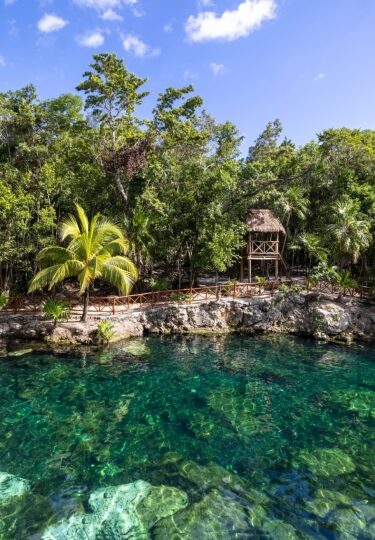With some 6,000 or more cenotes in the Yucatan Peninsula, about 150 are open to visitors, swimmers, and divers. So there’s plenty of choice when you’re looking to cool off in the best cenotes in the Riviera Maya.
The word cenote comes from the Yucatec Maya word “ts’onot”, meaning abyss or sinkhole. Cenotes exist because Yucatan is mainly formed from limestone. There are no rivers here, as any rain just disappears into its porous limestone. These underground flows form caverns and where they collapse, you have a cenote.
Cenotes are magical places where you can swim in cool, fresh water on the hottest of days. The Maya regarded them as sacred and precious items have been found by archaeologists in many cenotes, thrown in as offerings to the gods.
Today, as well as their spiritual significance, cenotes are wonderful places to swim, snorkel, dive, and simply enjoy the cave systems and lush greenery.
Casa Tortuga Cenote
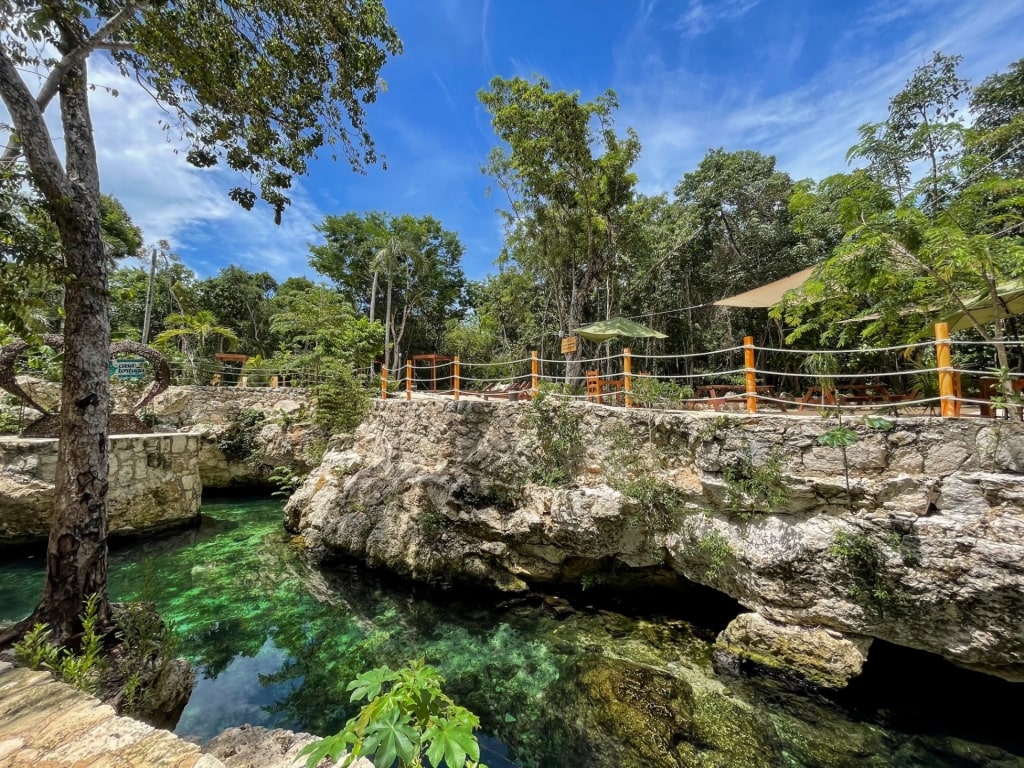
Casa Tortuga Cenote
This beautiful cenote, 45 minutes from Playa del Carmen, is within an eco-adventure park on the Caribbean coast. It’s one of the most accessible in Yucatan, a classic large pool surrounded by jungle.
There are actually four cenotes at Casa Tortuga, two open water and two caves. The main open pool, Tres Zapotes, is about 200 feet in diameter and up to 60 feet deep but with plenty of shallower areas for novice swimmers.
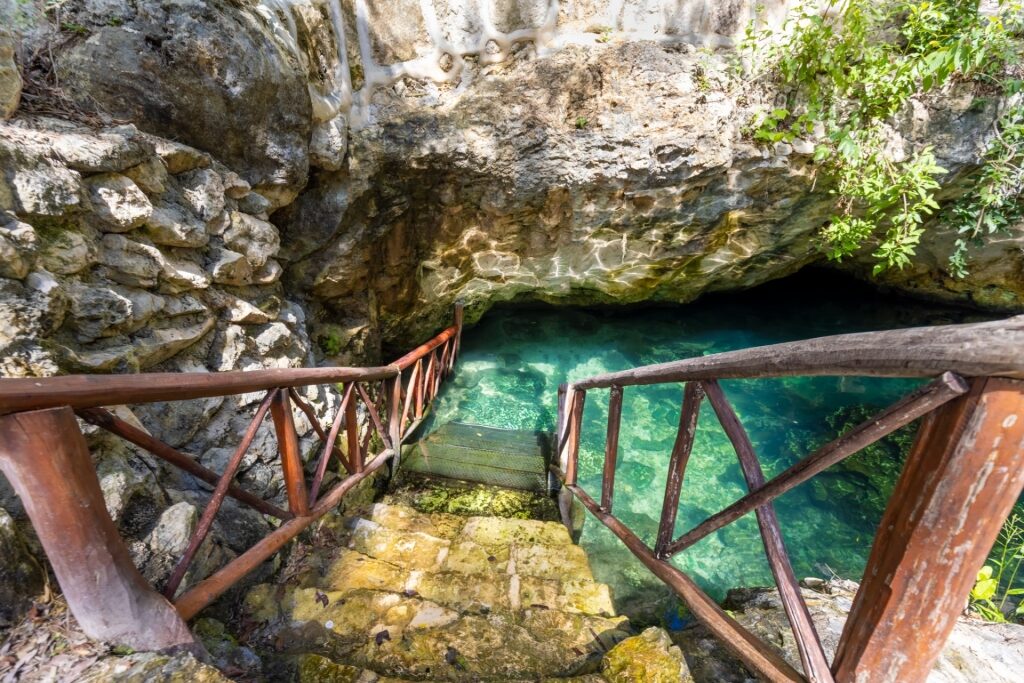
Casa Tortuga Cenote
Wooden platforms and stairs allow you to access the water easily, but do bring water shoes to move around in. As with most cenotes, the temperature of the water is a refreshing 75°F year-round.
Being semi-open, this cenote is a lovely space to enjoy splashing around in. Sunlight filters through the greenery to make a wonderful tropical picture.
You can snorkel or swim surrounded by colorful fish. As the “Tortuga” name implies, there are also turtles here, which you may spot.
Read: Best Beaches in the Riviera Maya
Cenote Dos Ojos
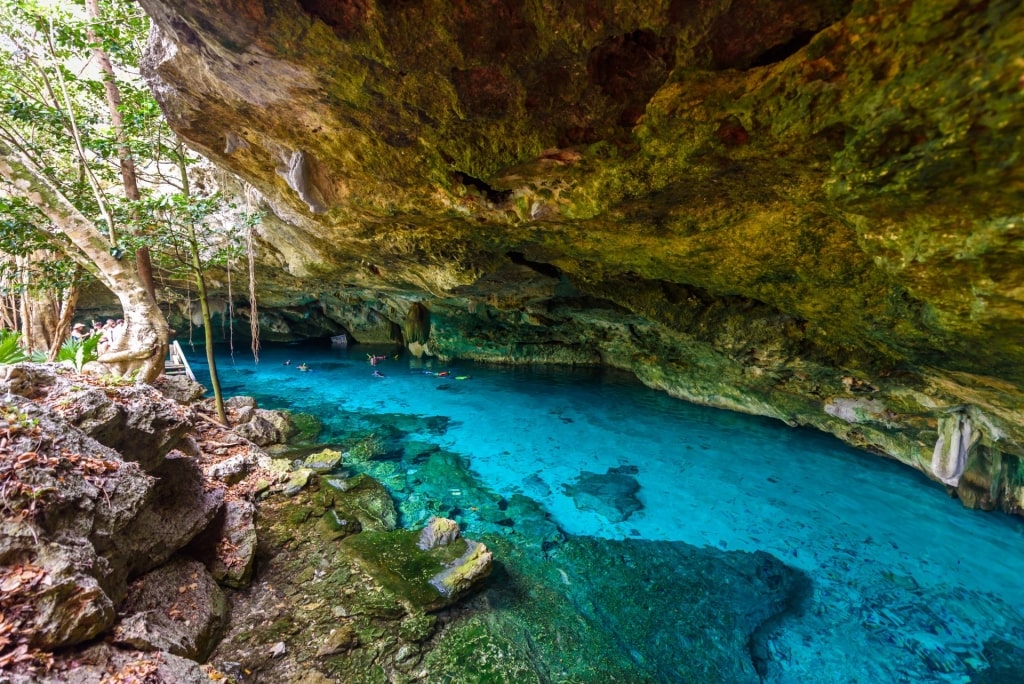
Cenote Dos Ojos
Cenote Dos Ojos, or “Two Eyes” in Spanish takes its name from its two main cenotes, both open to the air. They are connected by a large underwater cave system, making for a mini adventure to explore.
One of the most famous cenotes on the Yucatan Peninsula, Dos Ojos is a 90-minute drive from Playa del Carmen. It’s well-signposted and easy to reach from the main highway.
Surrounded by lush green tropical jungle, the scenic setting is a photographer’s dream. Underwater photographers will also enjoy the crystal clear water, home to many fish and even turtles.
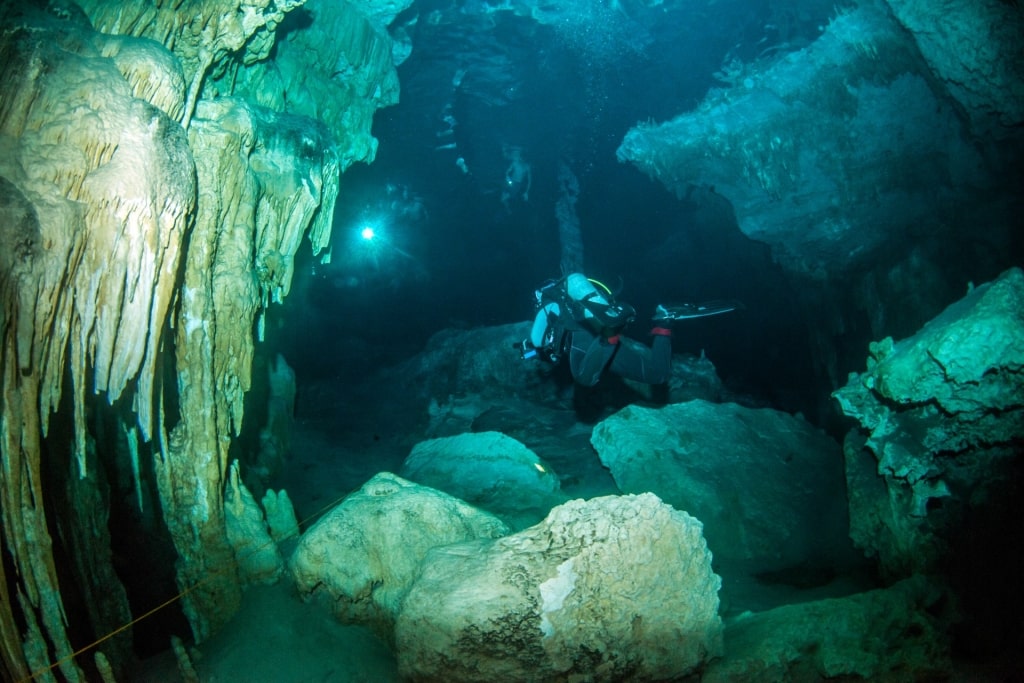
Cenote Dos Ojos
The cenote has both shallow and deeper sections, making it perfect for novice and experienced snorkelers. You’ll find that the light filtering through the water and the strange rock formations make for an extraordinary experience.
Certified divers come from all around the world to explore the intricate cave network. One section inhabited by bats—naturally dubbed “The Bat Cave”—is an extra thrill for divers.
Gran Cenote
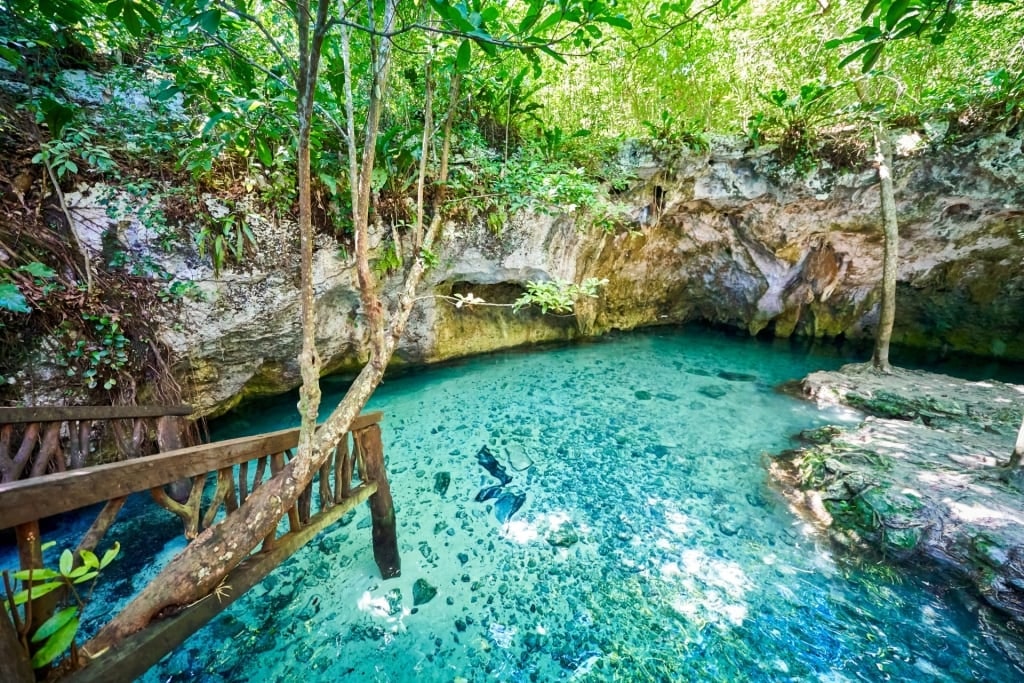
Gran Cenote
Gran Cenote, one of the best cenotes near Cancun, is about two hours from Tulum. A striking prominent feature is a wooden deck from which you can easily reach the water.
Before going in, you have to take a shower to remove any sunscreen. This is a common practice for cenotes, designed to help protect the delicate ecological balance of the water.
Swimming in a cenote is one of the best things to do in Mexico, and here, you’ll be among fish and turtles in open water that is perfectly clear. If you are brave enough, there is also a darker cave passage you can go through to reach a second pool.
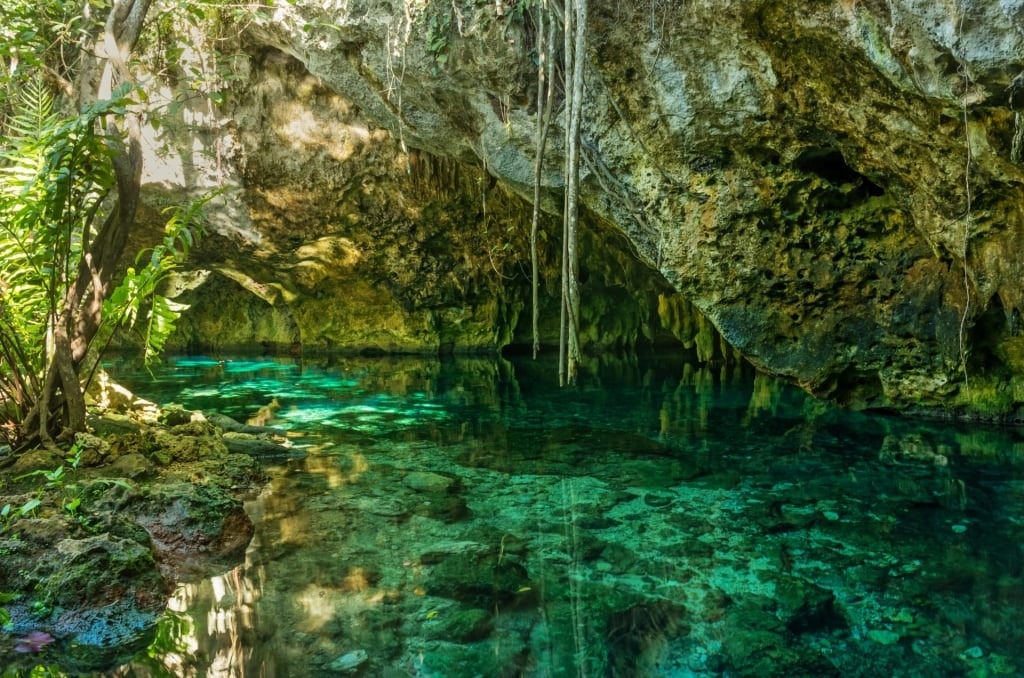
Gran Cenote
Gran Cenote is part of a much larger cave system with both open and roofed sections. Go deeper into the caves and you’ll see stalactites and stalagmites.
While you can rent both diving and snorkeling gear here, you might want to bring your own goggles or mask to any cenote. That always ensures a more comfortable fit, making for a more enjoyable experience.
Cenote Jardín del Edén
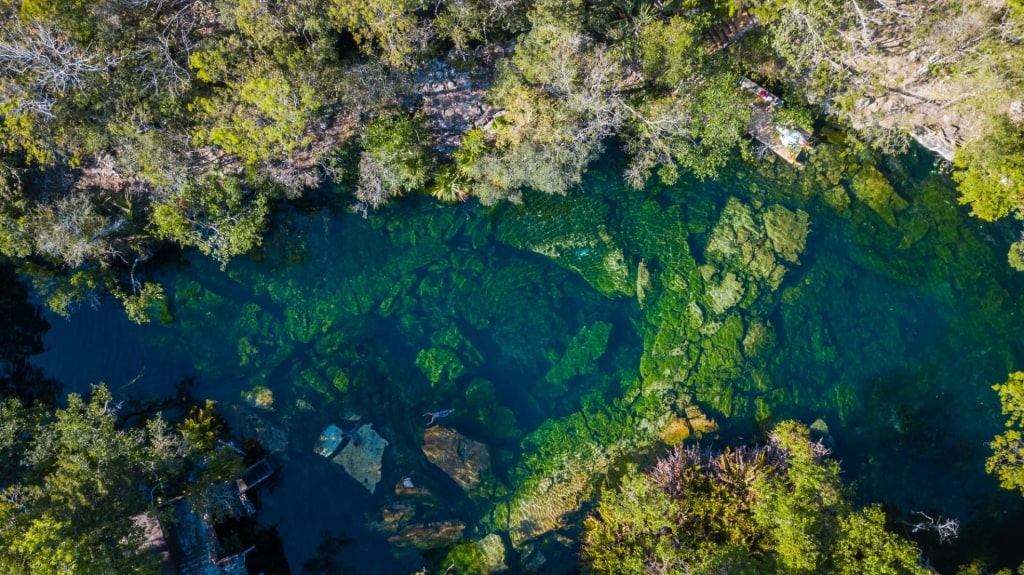
Cenote Jardín del Edén
Cenote Jardin del Eden, or the “Garden of Eden”, is near Puerto Aventuras, off Highway 307 some 15 miles south of Playa del Carmen. Its name perfectly captures the idyllic beauty of this pool of crystal-clear water, one of the loveliest cenotes in the Riviera Maya.
The large pool is from 10 to 50 feet deep, making it popular for diving as well as swimming. There are a number of spots on the rocks suitable for cliff jumping.
The rock formations continue underwater, giving snorkelers a view of some dramatic shapes. These changes in depth bring different colors to the water, while dappled sunlight filtering in adds to the spectacle.
Visibility is normally very good and you’ll see plenty of tiny fish. The limestone rock acts as a natural filter for any groundwater that finds its way into the cenote.
Afterward, relax with a picnic in the shade of some trees. The greenery overhangs the pool’s edges, making up an image that perfectly illustrates where its “Garden of Eden” name comes from.
Cenote Cristalino
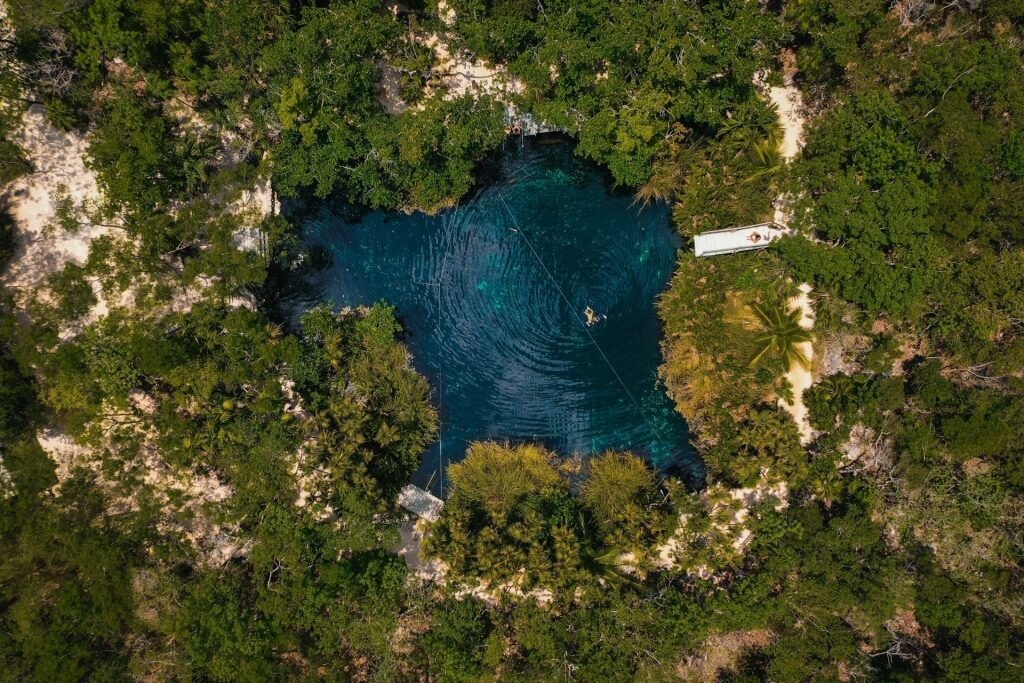
Cenote Cristalino
Cenote Cristalino is also outside Puerto Aventuras, very close to Cenote Jardín del Edén. Its name reflects its clear blue-green water, colored by invisible limestone particles.
This semi-open cenote is in a striking setting, surrounded by jungle. As with Cenote Jardín del Edén, you can swim, snorkel, or cliff jump.
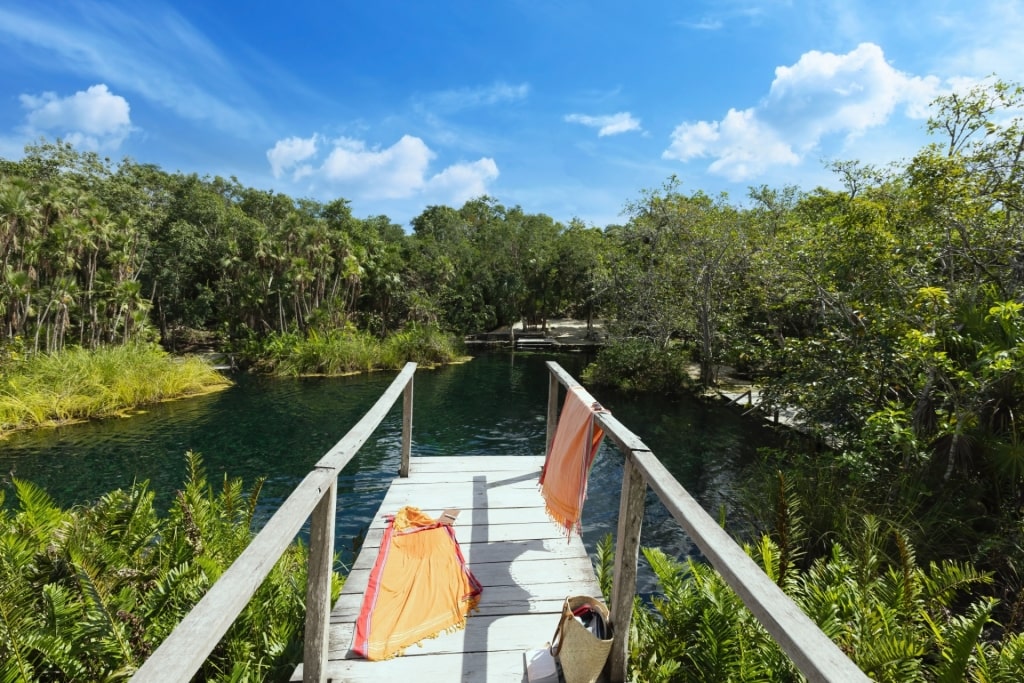
Cenote Cristalino
Depending on the time of day, parts of the pool are in shade, others in sunshine. There are also plenty of overhangs and underwater caves to add interest.
The shallower areas, where depths range from three feet to 20 feet, are perfect for novice swimmers or snorkelers. There are lockers, restrooms, and a small snack bar.
With any cenote, it’s a good idea to bring along a waterproof camera, as well as a dry bag for your belongings. Any dry bag is also a good place for storing your wet swimming costume and any towels afterward.
Cenote Chaak Tun
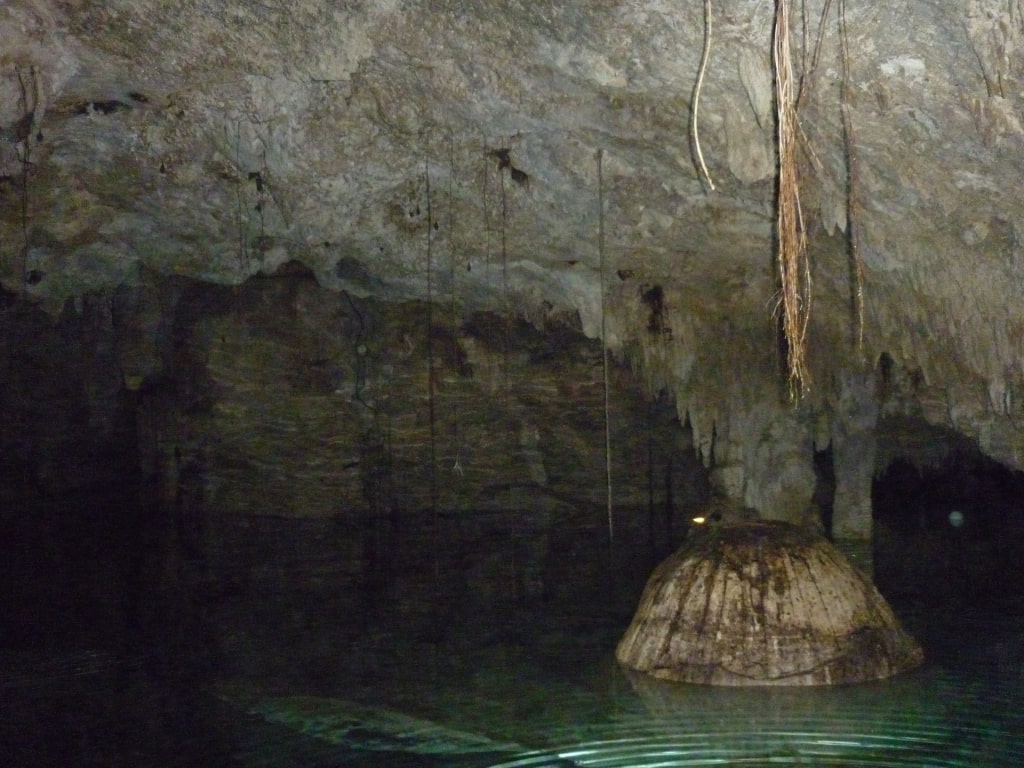
Cenote Chaak Tun
Cenote Chaak Tun, one of the very best cenotes in the Riviera Maya, is near the ancient Mayan ruins of Cobá. Its name means “Stone of the Rain God”, after the Maya rain god, Chaac.
This cenote is almost perfectly round, and nearly 200 feet across. At 75 feet deep, it was an important ceremonial center for the Maya, as is revealed by ancient stone steps.
Artifacts found here include ceramic pots with food remains, elaborately carved incense burners, and precious jade beads. This evidence points to it being a sacred site associated with the nearby city at Cobá.
The cenote was formed by the collapse of a large underground cave, and you can still see stalactites and stalagmites. The surrounding jungle envelopes the fallen edges, making for a picturesque view.
You can swim or snorkel in the cool, transparent water, or dive down to explore the underwater cave systems. The clear blue water here has given the cenote the nickname of “The Blue Hole”.
Cenote Aktun Chen
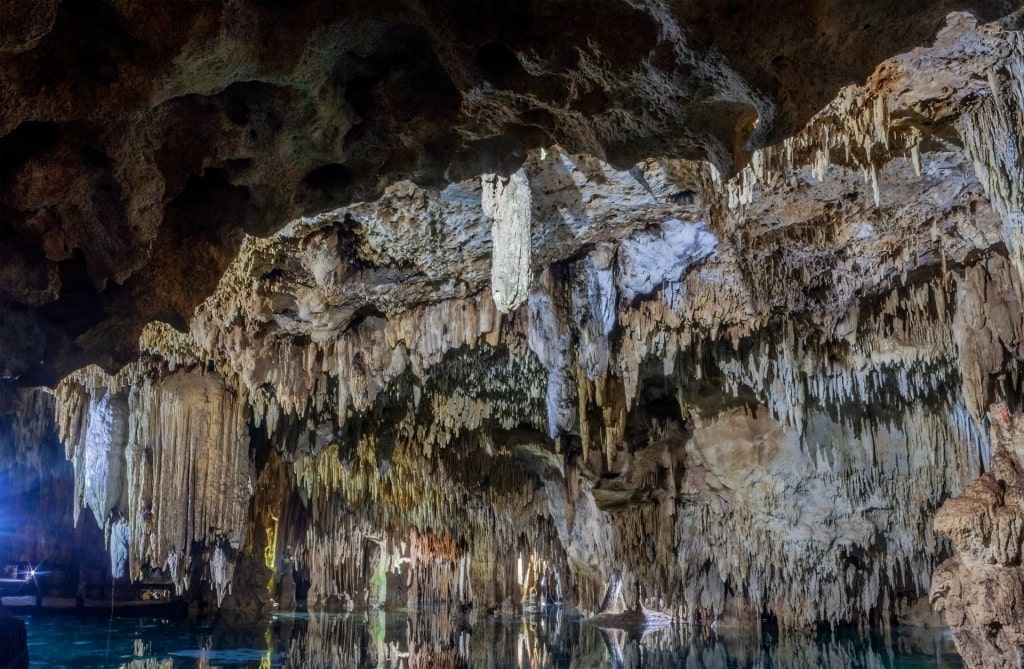
Cenote Aktun Chen
Another significant cenote near the Maya ruins of Cobá, Aktun Chen means “Ceramic Pot”. Pots, incense burners, and previous jade objects were found thrown into the cenote as ancient offerings.
The jade found here included beads, earrings, masks, and daggers. There were also pendants in the shape of humans and jaguars.
The Maya prized jade for its beauty and green jade was associated with water, life, and fertility. The amount found here suggests this was a very important spiritual site.
The sinkhole is around 197 feet in diameter, with depths of up to 100 feet. Shallower areas are served by a wooden platform, and lifejackets are mandated for all visitors.
Like most cenotes, the limestone walls have many centuries of deposits that make up interesting shapes. There are also some strange acoustics within the cavern that no doubt added to its otherworldliness for the Maya.
Cenote Taak Bi Ha
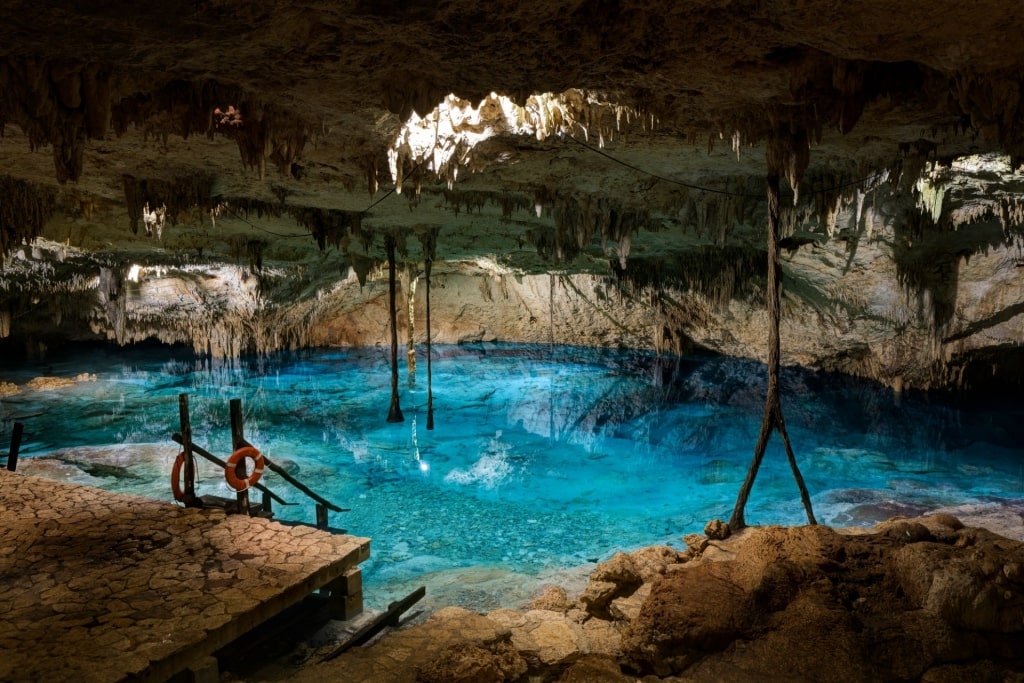
Cenote Taak Bi Ha
Very close to Cenote Dos Ojos, Cenote Tak Bi Ha is easy to visit on the same tour. It’s a massive sinkhole, notable for its sheer walls and abundance of stalactites.
The name Tak Bi Ha means “Water of the Carved Step”, a reference to the stone steps allowing access. There are also some Maya buildings, many ceremonial, around the rim.
This is one of the best places to snorkel in Mexico as much of the pool is shallow, making the water appear even clearer. Its pretty blue color is perfect for some lovely photographic memories.
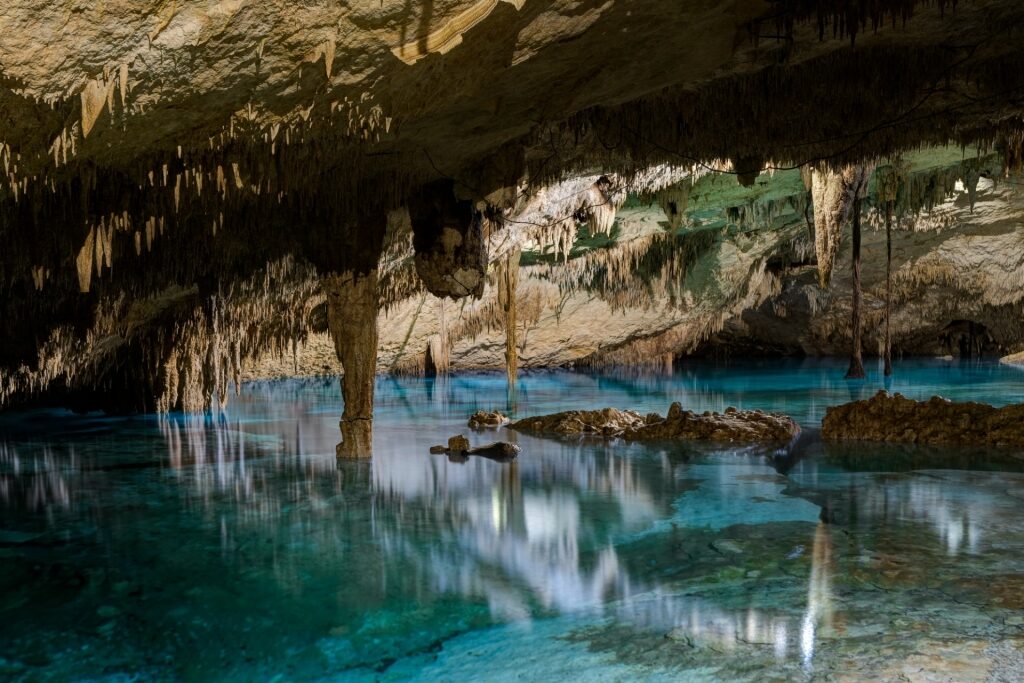
Cenote Taak Bi Ha
Archaeologists found many sacrificial objects here, ranging from precious jade pieces to musical ocarinas. These small ceramic wind instruments were often found in the shape of a frog, possibly being used in rituals to call for rain.
The Maya saw cenotes as portals to the underworld, the home of their deities, and a place to commune with the afterlife. As a source of water and hence life, these sinkholes were central to their physical and spiritual lives.
Cenote Chikin Ha
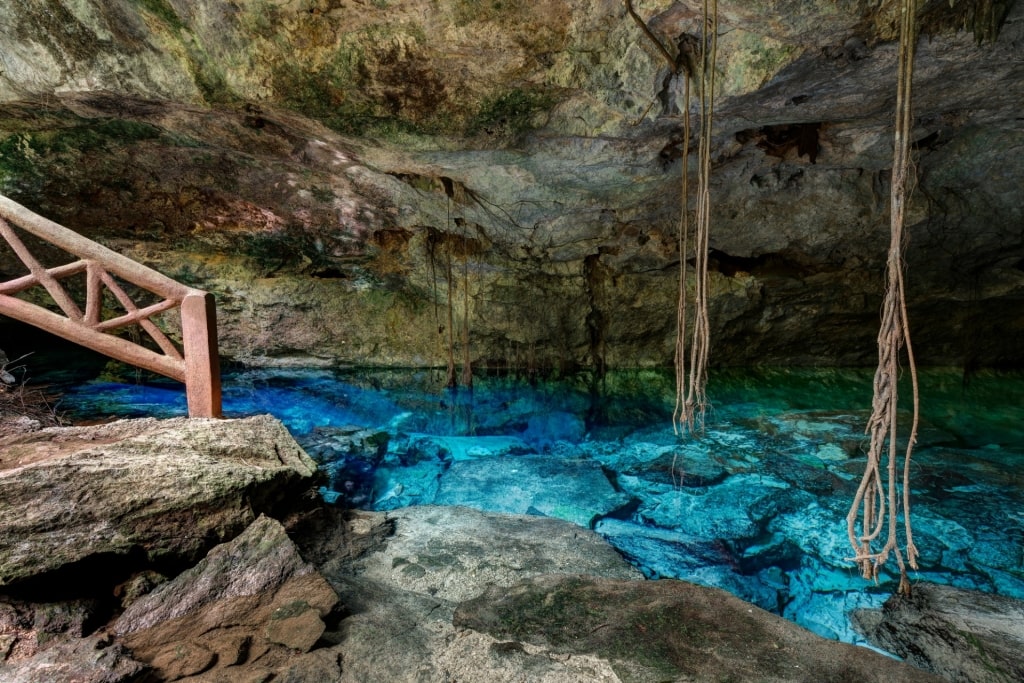
Cenote Chikin Ha
Chikin Ha—“Water of the West”—lies west of Cobá, and is made up of three cenotes. The main sinkhole is some 165 feet in diameter, with stone steps leading you down to the surface 80 feet below.
This cenote is split into two by a roofed passage that is great fun to swim through. You may come across divers who are allowed access to some deeper passageways.
A smaller, shallower cenote is perfect for children or less confident swimmers. No one could blame you for feeling chills in these cenotes, with their ancient sacrificial history.
A third cenote is not open to swimmers but makes an interesting sight. A guide will explain its ritual significance, and you might spot some bats or mot-mot birds.
Cenote Nicte-Ha
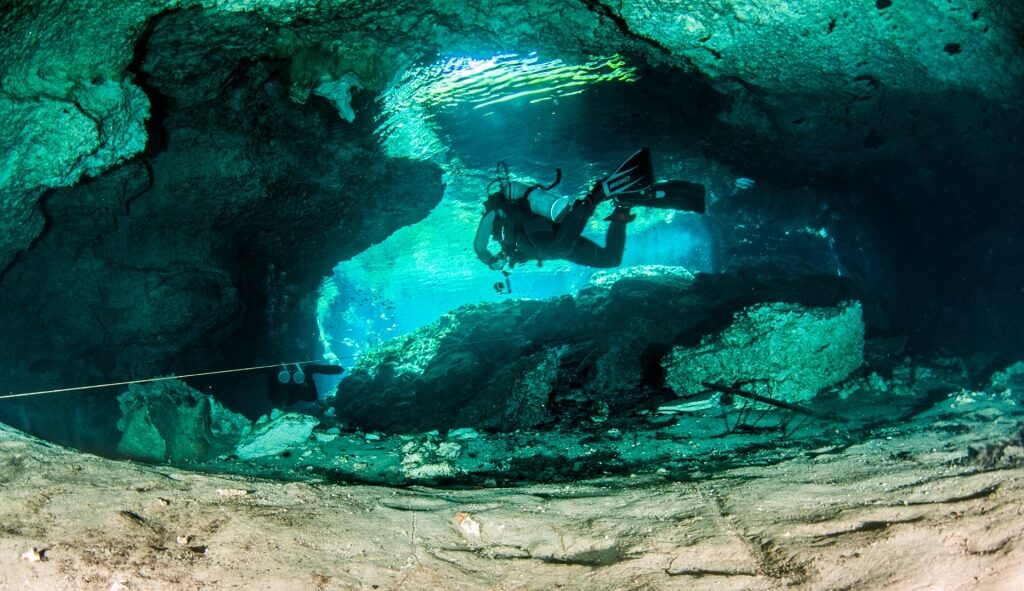
Cenote Nicte-Ha
The many lilies floating on the surface of Cenote Nicte-Ha give it its name. Nicte-Ha translates as “Water of the Flower Bud” in the Mayan language.
It’s another large open-air pool some 130 feet in diameter, perfect for swimming. There are stone steps that take you down 65 feet to the water.
The steps are an indication this cenote was of ritual significance in centuries past. Archaeologists have found ceramics, jade, and incense burners, among other artifacts.
The lilies and the exposed tree roots hanging down its walls, make this cenote one of the most picturesque in Yucatan. It’s protected within the Coba ecological park so you can help the ecosystem here by wearing a rash-vest rather than sunscreen.
Read: Mexican Culture & Traditions
Cenote Tajma Ha
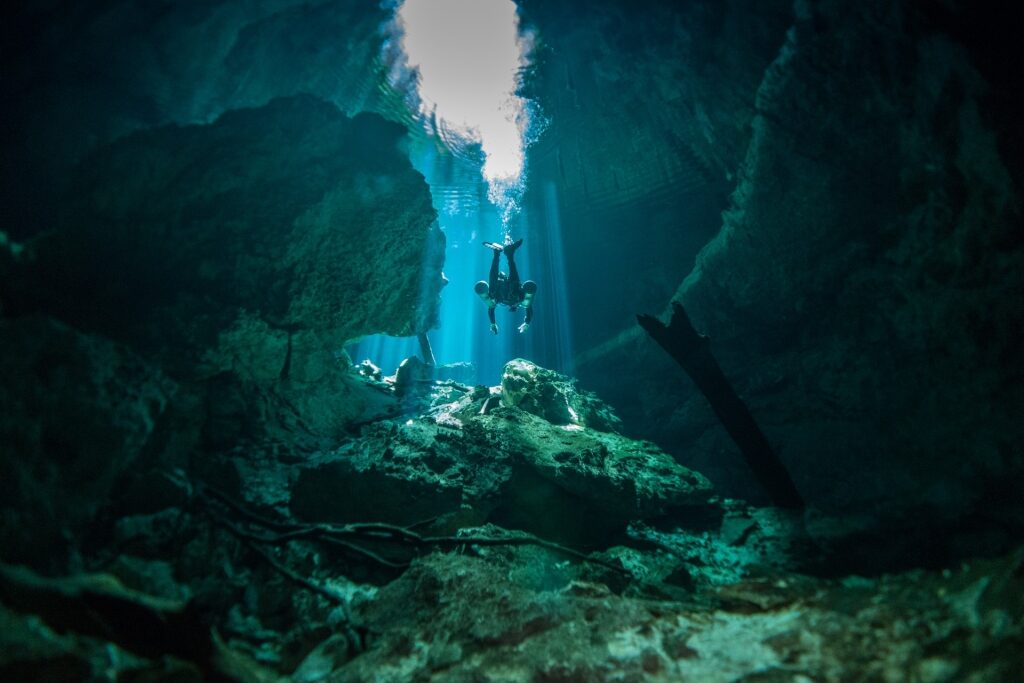
Cenote Tajma Ha
Standing about 20 miles south of Playa del Carmen, Tajma Ha’s name was inspired by India’s majestic Taj Mahal. Called that by early European explorers, an inspired punster gave it the name of Tajma Ha, meaning “Hidden Water”.
This is a cenote for divers with some experience, as there are some narrow passages and good buoyancy control is important. Non-diving companions can enjoy watching out for “mot-mots”, the colorful tropical birds the Maya consider guardians of the cenotes.
Dive into its dark depths and you can understand why the Maya thought cenotes were the gateway to the underworld. Looking back up, you see multiple beams of sunlight dappling the surface.
A halocline of salt water meeting fresh water can create a startling mirror effect under certain conditions. What’s more, projections in the rock underwater look like moving faces or other creatures of the imagination in the changing light.
Cenote Chempita
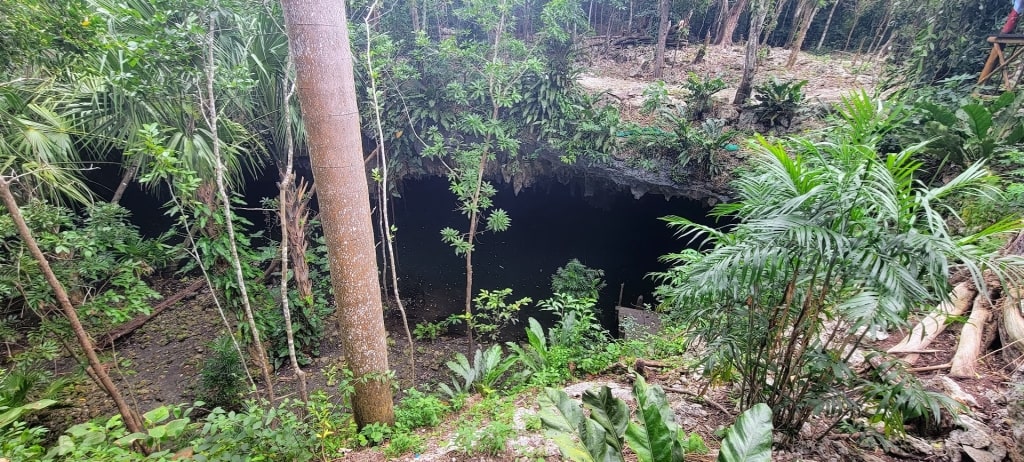
Cenote Chempita Photo by JillRG on Wikimedia Commons, licensed under CC BY 4.0
Cenote Chempita translates to “Jade Cavern”, and you’ll understand why when you see it. Its vibrant emerald color comes from suspended limestone particles catching the sunlight.
Visiting here is one of the best things to do in Cozumel, where you can swim in the clear water and enjoy a 20 foot jump off the cliff. Remnants of the roof overhang parts of the central pool, offering shade and stalactites.
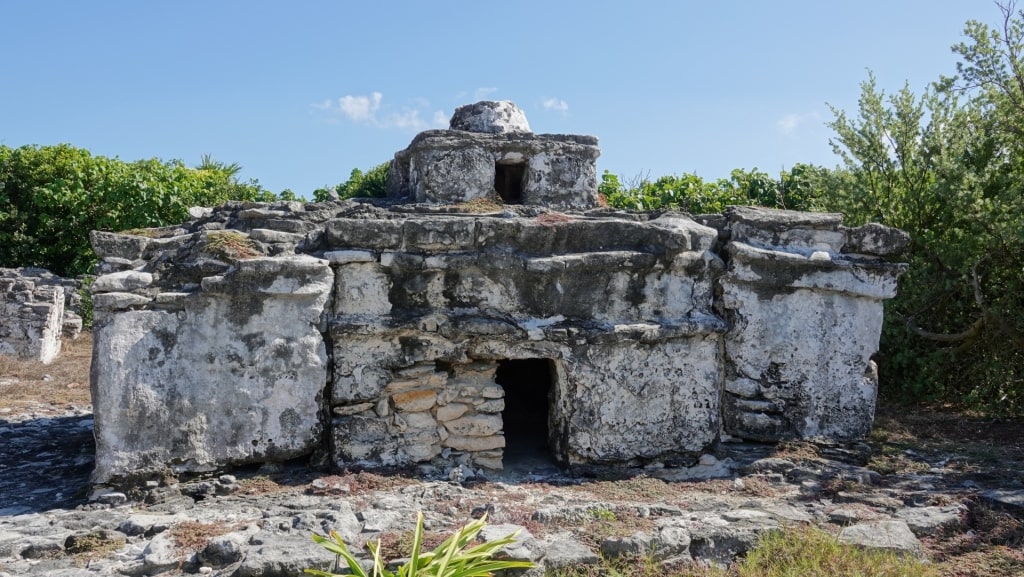
El Cedral, Cozumel
The cenote is near El Cedral in the center of Cozumel. It’s reached by an adventurous 30-minute journey by 4×4 or ATV on dirt tracks amid thick jungle.
The cave was once used by the Maya for ceremonial rituals and its history is well worth hearing from one of the local guides. This is also a chance, here in the heart of the tropical forest, to hear about the local flora and fauna.
This cenote also has bats which, while fascinating, can give it a sulfurous air if it hasn’t rained for a while. Time your visit for the wet season to avoid this.
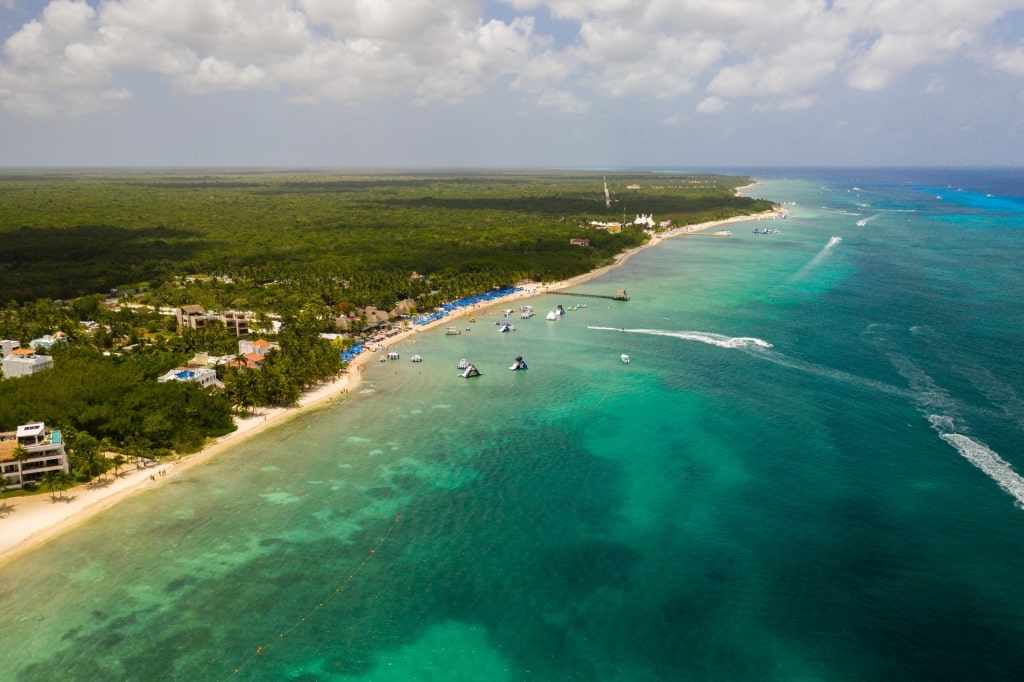
Cozumel
Has this guide to the best cenotes in the Riviera Maya tempted you to take the plunge? Then browse our Mexico cruises to find the perfect vacation.
